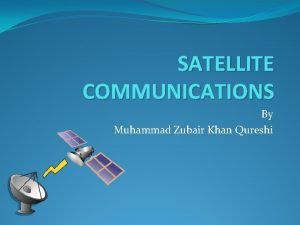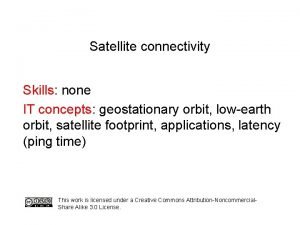Processing Himawari8 Geostationary Satellite Data Using GOESR Algorithms

- Slides: 1

Processing Himawari-8 Geostationary Satellite Data Using GOES-R Algorithms for Algorithm Continuity in Operations Jonathan Wrotny 1, A. Li 1, H. Xie 1, M. Fan 1, R. Chen 1, T. Yu 1, S. Sampson 1, W. Wolf 2, W. Straka 3, A. Heidinger 4, and Jaime Daniels 2 1 IMSG, 2 NOAA/NESDIS/STAR, College Park, MD 20740, USA 3 CIMSS, Madison, WI 53706, USA 4 NOAA, Madison, WI 53706, USA • The GOES-R Algorithm Working Group (AWG) Algorithm Integration Adapting the AWG Framework for AHI Data Team (AIT) maintains and updates a data processing framework for GOES -R algorithm processing. • The majority of the AWG Level 2 geophysical algorithms were Overview originally developed and tested with a primary source of satellite data, e. g. AQUA/MODIS or MSG/SEVIRI. Additional datasets supported development in some cases, e. g. AVHRR. • This system provides an environment for algorithm development and testing along with the ability to process multiple algorithms in sequence with product precedence. Most of the algorithms are able to process on multiple satellite datasets. • As preparation for the upcoming GOES-R, the algorithms were expanded for use with ABI-simulated data. These data are simulations from the WRF model. • With the launch of the Japanese Himawari-8 satellite in October 2014, a new next-generation geostationary dataset is available for use, and the AIT Framework is currently being updated to utilize these data. • Approximately half of the 20 AWG algorithms were adapted to read and process on VIIRS data from the S-NPP mission. This work has occurred under the ‘JPSS Risk Reduction Project. ’ • This poster describes updates made to the GOES-R Framework to process AHI data for algorithm use. • Update algorithm to ingest AHI data (AIT is involved, as well). • Determine algorithm-specific coefficients/thresholds which optimize outputs for use with AHI data. • Update Look-Up Tables (LUTs), if necessary, which supply additional physical coefficients to the algorithm specific to AHI. • If necessary, update algorithm to handle AHI spectral channel 0. 51 µm but not a channel at 1. 38 µm (opposite the GOES-R ABI instrument). AWG Science Team Input • Obtain AHI algorithm code from AWG science team (AIT is involved, as well). • Obtain AHI-specific spectral and absorption coefficients required for CRTM. • Obtain AHI native data format reader from JMA. Modify reader for navigation and Framework data format compatibility. Other Inputs Integration by AIT • Integrate algorithm code into AWG Framework. • Now, with the launch of the Himawari-8 satellite, data is available from the Advanced Himawari Instrument (AHI). AHI is a close proxy of the GOES-R Advanced Baseline Imager (ABI). In time, all of the AWG Level 2 algorithms will be modified to run on AHI data. AHI Derived Motion Winds Project • The process to update the AWG algorithms for use with AHI data involves multiple groups of people and a step-by-step process before an updated algorithm is baselined in the AIT processing system. The figure to the right describes this process. • The first algorithm to be updated for use with Himawari/AHI data is the Derived Motion Winds (DMW) algorithm as part of the ‘AHI Derived Motion Winds Project. ’ • The development of an AHI Product Processing System will help continue algorithm continuity of operations for the MTSAT satellite (which is approaching end-of-life in 2015) and bridge the gap from SNPP to the first JPSS satellite (J 1) launched in 2017. Figure 1. Description of the process taken to update the AWG retrieval algorithms to use Himawari/AHI data. Major steps and sub-tasks are shown. AHI Winds Product System Operational Design • The project is a demonstration of NOAA’s goal of ‘Enterprise Solutions, ’ namely using similar algorithms for geostationary and polar orbiting satellites. • The AHI Product Processing System is being developed by various partners: • The project will provide an operational test of the GOES-R DMW algorithm before GOES-R launch. 1) Scientific algorithm development for the Cloud and Wind algorithms is performed by the Algorithm Working Group (AWG) science teams at NOAA/NESDIS/STAR (with support by the AIT). • The DMW algorithm source code is being updated for use with AHI data by the AWG DMW science team with contributions by the GOESR AIT, as well. The Cloud Mask, Cloud Height, and Cloud Phase algorithms are also adapted for AHI data since these algorithms are needed as inputs to the DMW algorithm. • The most current versions of the DMW and cloud algorithms are being used in the Winds project. For the cloud algorithms, these versions are those that have been adapted to read and process on both NPP VIIRS and Himawari/AHI data. Initially, the ABI ‘Baseline’ algorithms will be used in order to achieve a working process. The DMW algorithm used in the Winds project will likely be quite similar to the GOES-R ABI version of the algorithm. Table 1. Current status of Winds project. Key required elements are listed an indication if these elements have been completed. Winds Wind Project Element Received from AWG Integrated into team/Coded by AIT? Framework? Tested? Completed? AHI data reader code* Yes Yes** AHI-specific coefficients for CRTM Yes Yes*** Cloud Mask Algorithm code Started No No Cloud Mask Algorithm Look. Up Tables No No Cloud Phase Algorithm code No No Cloud Phase Algorithm Look. Up Tables No No Cloud Height Algorithm code No No Cloud Height Algorithm Look -Up Tables No No Winds Algorithm code Winds Algorithm Look-Up Tables No No *AHI data reader code: code from JMA to read AHI L 1 b files (radiances, BTs); ‘geos_transform. c’ from William Straka (CIMMS) for latitude/longitude calculations; AIT updates to code to make AHI data compatible with Framework data structures* **An issue was identified with the Ch. 7 pseudo-reflectance related to units. A fix is being worked. ***Updates may occur to CRTM coefficients in the future*** 2) The software processing system is developed by the Algorithm Integration Team (AIT) at NOAA/NESDIS/STAR. • • The processing system is being developed as an operational demonstration (preoperational) running in near real-time as data is obtained from the Japan Meteorological Agency (JMA). Algorithm software is written in Fortran 90 that conforms to strict coding standards. Cloud and DMW Algorithm Inputs Table 2. The following table lists the inputs for the three Cloud algorithms (that are run prior to running the DMW algorithm) and the DMW algorithm itself. Cloud Mask Cloud Phase/Type Cloud Height AHI Winds AHI L 1 B NWP – GFS OISST Snow Mask Land Mask Desert Mask Coast Mask Surface Type Surface Elevation Surface Emissivity Pseudo Emissivity Surface Albedo CRTM Unit/Sub-Unit AHI Cloud Mask • Upon completion, the system will be transitioned to NOAA/OPSO for further development and testing. Operational processing of the system will occur at NOAA/ESPC. Operational Winds (at 6 visible to IR wavelengths), Cloud (Cloud Mask, Cloud Top Phase, Cloud Type, Cloud Top Temperature, Cloud Top Pressure, Cloud Top Height), Cloud and Moisture Imagery (at 16 visible to IR wavelengths), and Radiance (at 16 visible IR wavelengths) data products will be sent to the National Weather Service (NWS). Data products will be available at the NOAA Distribution Environment (DDS). AHI Cloud Phase/Type AHI Cloud Top Height, CTP & CTT Expected Error Coefficient File Clear Sky Coefficient File Future Work Figure 2. System-level diagram of the AHI Winds Product System. • Obtain AHI versions of the Cloud Mask, Cloud Phase, Cloud Height, and DMW algorithm code from AWG science teams and integrate/test these codes in the AWG Framework system. • Generate AHI Product System outputs in a near-real time operational demonstration. • Prepare the Algorithm Package (DAP) for the AHI Product System and deliver to NOAA/OSPO. • Obtain AHI versions of the remaining Level 2 processing algorithms from AWG science teams and integrate these in the AWG Framework system. • Perform routine regression testing and near-real time processing for AHI versions of the Level 2 algorithms. AHI Winds Data Users • AHI Radiances wills be used by the NWS for data assimilation and Imagery product creation. • DMW will be used by the NWS field offices. • The DOD will use the AHI radiances in model forecasts. Early Data Distribution to GOES-R Partners • The GOES-R AIT obtains AHI data in near real-time (every 3 minutes) from the NOAA STAR Central Data Repository (SCDR). • A script is run (every 10 minutes) which pushes the data with RSYNC to Univ. of Wisc. /CIMMS and Colorado St. /CIRA. • A script is run (every 3 minutes) which pushes the data with ‘scp’ to an ‘ftp 2’ site. The NWS retrieves the AHI data from the ‘ftp 2’ site. References 1 GOES-R Algorithm Theoretical Basis Documents (http: //www. star. nesdis. noaa. gov/goesr/docs_reports_ATBD. php) Acknowledgments Thanks to the JMA for sample source codes to read the Himawari standard data.

